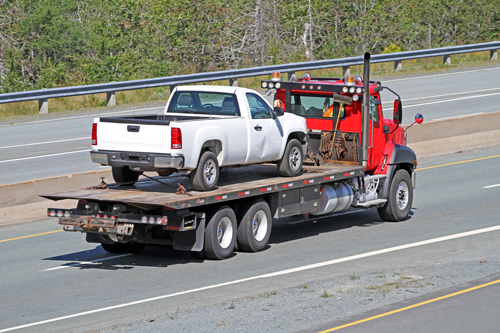Car trouble is stressful. Choosing the wrong towing service can make it worse. Most people picture a wheel-lift truck pulling a car with two tires on the road. That can work in some situations. In many others, a flatbed is the safer and smarter choice. A flatbed loads the entire vehicle onto a platform so nothing rolls, nothing drags, and nothing gets chewed up by debris.
This guide explains when a flatbed really matters, why it protects your car, and what to ask for when you call a towing company.
All-Wheel Drive and Four-Wheel Drive Require It
If your vehicle sends power to all four wheels, a flatbed is the only safe way to tow. Traditional wheel-lift towing leaves two wheels on the ground, which forces parts of the drivetrain to move in ways they were never designed to. This can create heat, strain, and internal damage in the transmission or transfer case.
Repairing those components is not cheap. For most AWD or 4WD owners, the cost of a flatbed tow is nothing compared to the price of fixing a damaged driveline. Manufacturers even note in owner’s manuals that flatbed towing is required. If your vehicle has an AWD or 4WD badge, remember to ask for a flatbed right away.
Long Distances Are Safer on a Flatbed
Dragging a vehicle behind a tow truck for more than a short drive creates multiple risks. Tires can wear unevenly, suspension parts take on strain, and the car remains exposed to every pothole, curb, and piece of debris on the road.
Flatbed towing removes those risks entirely. The vehicle rides on the platform, strapped securely in place. Whether you are moving it across town or across state lines, it will arrive without additional wear or damage.
If you know your tow is more than a few miles, a flatbed is the smarter choice.
Lowered and Modified Cars Need Gentle Loading
Drivers who have invested in aftermarket modifications know how sensitive these vehicles can be. Lowered suspensions, body kits, and performance exhausts all sit closer to the ground. Traditional towing angles often scrape or bend those parts.
Flatbeds use extended ramps that allow for smooth loading without sharp angles. That keeps bumpers, lips, and exhaust systems intact. If you have spent money customizing your car, a flatbed tow is the way to protect that investment.
Everyday Vehicles Benefit Too
Even if your car is not AWD, lowered, or modified, a flatbed may still be the safest option. There are plenty of situations where standard cars are better off riding on a flatbed:
- Vehicles with transmission issues that should not be rolling
- Non-running cars with locked wheels or severe accident damage
- Classic or older cars where every detail matters
- Luxury vehicles where paint and trim need extra protection
- Vehicles with oversized wheels or low-profile tires that can be damaged by dragging
Flatbeds are not only for specialty vehicles. They can save headaches for everyday drivers, too.

Flatbeds Versus Wheel-Lift Tow Trucks
Wheel-lift trucks are still common because they are faster to operate and often less expensive. They hook the vehicle from the front or rear and keep two tires on the ground. While that might work for a short tow, it leaves the car vulnerable to the road.
Flatbeds cost a little more but provide full protection. Since the entire vehicle is lifted off the ground, there is no rolling, no exposure to debris, and no added strain on moving parts. For many drivers, that small price difference is worth avoiding a repair bill later.
Clear Signs You Should Ask for a Flatbed
Not sure whether you need a flatbed? Here are the key situations that make it worth requesting:
- Your car is AWD or 4WD
- The tow will be longer than a few miles
- The vehicle has been lowered or heavily modified
- You are transporting a classic, luxury, or collector car
- The car is not drivable due to transmission failure or locked wheels
- You want the lowest risk option, no matter the vehicle type
Towing companies may not send a flatbed automatically. Be clear when you call that you need one, and explain why. This ensures the right truck is dispatched the first time.
How to Prepare Before the Flatbed Arrives
A little preparation makes loading smoother and safer. Here are a few quick steps:
- Remove valuables and loose items from inside the car
- Keep the keys and wheel lock key ready
- Clear space in front of the car if possible
- Let the driver know if there are any modifications or clearance issues
- If your vehicle is extremely low, ask if the driver has extra ramps or blocks for a gentler angle
These small details can save time and prevent mistakes.
The Value of Choosing a Flatbed
A flatbed tow may cost slightly more, but it almost always saves money and stress in the long run. Instead of worrying about tire wear, scraped bodywork, or drivetrain damage, you know the car is fully protected.
For owners of AWD vehicles, modified cars, or anything high-value, a flatbed is not just the best choice, it is the only choice. For everyone else, it is the option that reduces risk and keeps things simple.
The Right Tow Truck for the Job
Flatbed towing is not about style. It is about safety and protection. Lifting the vehicle off the road removes the biggest risks that come with traditional towing methods.
When you call for a tow, think about your vehicle type, the distance it will travel, and any unique features that need protection. If there is any doubt, ask for a flatbed. It may cost more up front, but it prevents the kind of problems that turn a simple tow into an expensive repair.
Contact Around the Clock Towing in Mesquite, TX, to schedule a tow!

